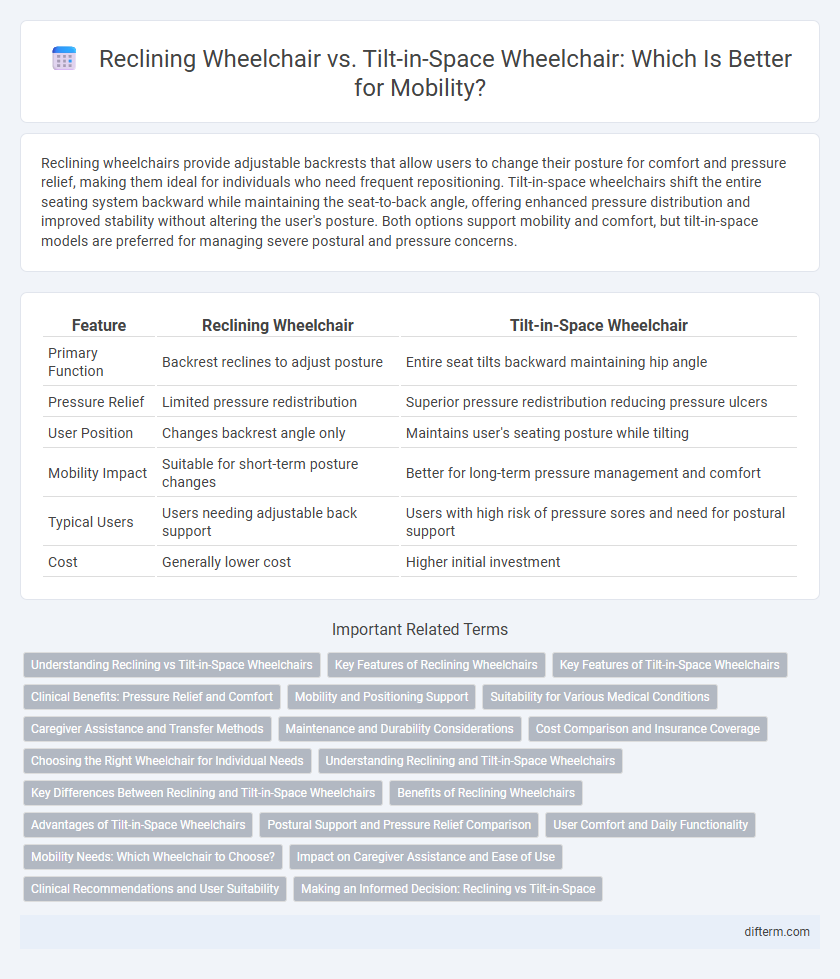Reclining wheelchairs provide adjustable backrests that allow users to change their posture for comfort and pressure relief, making them ideal for individuals who need frequent repositioning. Tilt-in-space wheelchairs shift the entire seating system backward while maintaining the seat-to-back angle, offering enhanced pressure distribution and improved stability without altering the user's posture. Both options support mobility and comfort, but tilt-in-space models are preferred for managing severe postural and pressure concerns.
Table of Comparison
| Feature | Reclining Wheelchair | Tilt-in-Space Wheelchair |
|---|---|---|
| Primary Function | Backrest reclines to adjust posture | Entire seat tilts backward maintaining hip angle |
| Pressure Relief | Limited pressure redistribution | Superior pressure redistribution reducing pressure ulcers |
| User Position | Changes backrest angle only | Maintains user's seating posture while tilting |
| Mobility Impact | Suitable for short-term posture changes | Better for long-term pressure management and comfort |
| Typical Users | Users needing adjustable back support | Users with high risk of pressure sores and need for postural support |
| Cost | Generally lower cost | Higher initial investment |
Understanding Reclining vs Tilt-in-Space Wheelchairs
Reclining wheelchairs allow the backrest to tilt backward independently, enhancing user comfort by redistributing pressure and providing postural support. Tilt-in-space wheelchairs maintain the angle between the seat and backrest while tilting the entire seating system backward, which helps prevent pressure ulcers by reducing shear forces and promoting better circulation. Choosing between reclining and tilt-in-space wheelchairs depends on individual needs for pressure management, postural stability, and mobility support.
Key Features of Reclining Wheelchairs
Reclining wheelchairs feature a backrest that tilts backward, allowing users to adjust their seating position for enhanced comfort and pressure relief. This design supports individuals with limited trunk control by redistributing weight and reducing the risk of pressure sores. Key elements include adjustable headrests, extendable leg rests, and manual or power reclining mechanisms to accommodate various mobility needs.
Key Features of Tilt-in-Space Wheelchairs
Tilt-in-space wheelchairs provide pressure relief and improved posture by allowing the entire seating system to tilt backward while maintaining the hip, knee, and ankle angles. These wheelchairs enhance comfort and support for users with limited mobility, reducing the risk of pressure ulcers through pressure redistribution. Key features include adjustable tilt angles, integrated head and leg supports, and customizable seating options tailored to individual posture needs.
Clinical Benefits: Pressure Relief and Comfort
Reclining wheelchairs improve pressure relief by allowing users to adjust the backrest to various angles, reducing shear forces and promoting blood flow to prevent pressure ulcers. Tilt-in-space wheelchairs maintain a constant seat-to-back angle while tilting the entire seating system, providing superior pressure redistribution and enhanced comfort, especially for users with limited trunk control. Clinical studies show tilt-in-space wheelchairs offer greater long-term skin integrity benefits, reducing the risk of pressure injuries in high-risk populations.
Mobility and Positioning Support
Reclining wheelchairs offer enhanced upper body positioning by allowing the backrest to tilt backward independently, which improves pressure relief and comfort for users with limited trunk stability. Tilt-in-space wheelchairs shift the entire seating system backward while maintaining fixed angles between the seat and backrest, providing superior postural support and reducing shear forces for individuals with severe mobility impairments. Both wheelchair types enhance mobility by facilitating customized positioning, but tilt-in-space wheelchairs generally provide better long-term pressure management and postural alignment.
Suitability for Various Medical Conditions
Reclining wheelchairs offer adjustable backrests suitable for users with conditions such as spinal cord injuries, multiple sclerosis, or severe posture problems, providing pressure relief and improved comfort. Tilt-in-space wheelchairs maintain a fixed seat-to-back angle while tilting the entire seat frame, which benefits individuals with severe muscle tone issues, preventing shear and promoting pressure distribution for conditions like cerebral palsy or stroke. Choosing between these wheelchairs depends on specific medical needs, mobility levels, and the requirement for pressure management or posture support.
Caregiver Assistance and Transfer Methods
Reclining wheelchairs offer adjustable backrest angles that ease caregiver assistance by allowing smooth patient repositioning, reducing strain during transfers. Tilt-in-space wheelchairs maintain a fixed seat-to-back angle while tilting the entire seating system backward, providing pressure relief without altering hip and knee positions, which optimizes transfer techniques. Caregivers benefit from tilt-in-space designs by minimizing postural adjustments, enhancing safety and efficiency during patient lifts and repositioning.
Maintenance and Durability Considerations
Reclining wheelchairs generally require more frequent maintenance due to the additional moving parts in the backrest mechanism, which may wear out over time and need lubrication or adjustment. Tilt-in-space wheelchairs feature a robust design with fewer adjustable joints, enhancing overall durability and reducing maintenance demands. Choosing between the two depends on the user's need for positional support balanced against the ease of upkeep and long-term reliability.
Cost Comparison and Insurance Coverage
Reclining wheelchairs typically range from $500 to $2,500, while tilt-in-space wheelchairs often cost between $2,000 and $8,000 due to advanced pressure relief features. Insurance coverage varies; many policies and Medicare may partially cover tilt-in-space wheelchairs when prescribed for complex medical needs but often offer limited reimbursement for reclining wheelchairs. Understanding specific insurance plans and medical necessity documentation is crucial for maximizing coverage and minimizing out-of-pocket expenses.
Choosing the Right Wheelchair for Individual Needs
Reclining wheelchairs offer adjustable backrests ideal for users needing pressure relief and varied seating positions, while tilt-in-space wheelchairs maintain a fixed seat-to-back angle, allowing for full-body tilt to reduce pressure and improve circulation. Selecting the right wheelchair depends on factors like mobility level, postural support requirements, and daily activities, ensuring optimal comfort and health outcomes. Consulting healthcare professionals and assessing functional goals are essential for personalized wheelchair choices.
Reclining wheelchair vs Tilt-in-space wheelchair Infographic

 difterm.com
difterm.com